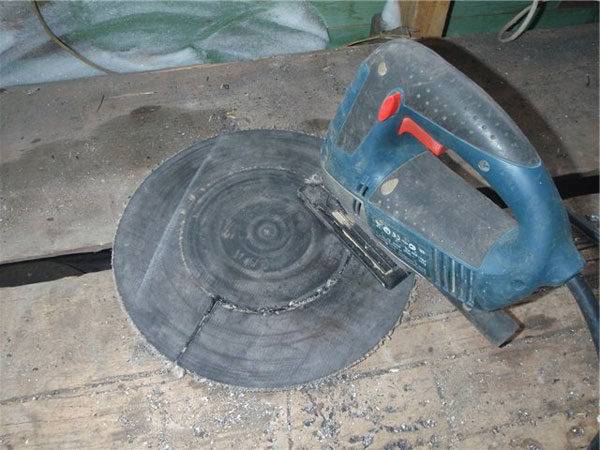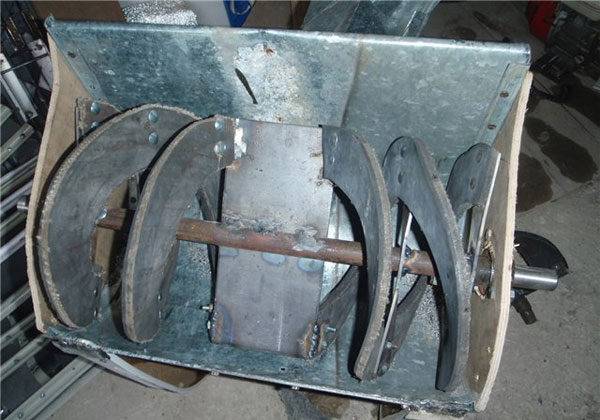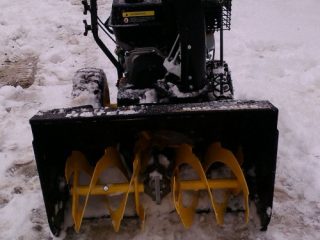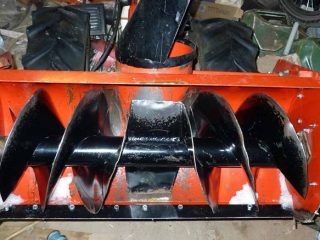Content
The demand for a snow blower arises at a time when, after a snowfall, it is necessary to clear a large area. The prices for such factory-made equipment are quite high, so craftsmen try to make it themselves. The main working mechanism of a snow blower is an auger. To make it, you will need accurate drawings. Errors made in the calculations will lead to the snowblower being thrown to the sides during operation. Now we will look at how to make a do-it-yourself auger for a snow blower from a steel sheet and a conveyor belt.
Screw design and principle of its operation
It is not difficult to assemble an auger snow blower with your own hands. Here it is important to maintain the same distance between the spiral knives so that the machine does not wobble during operation. Such homemade products are powered by an electric motor or a motor from a motor cultivator, chainsaw and other similar equipment. The auger design itself can serve as an attachment for a walk-behind tractor.
Auger snow blowers come in two varieties:
- The single-stage snow blower is equipped with a single auger with spiral blades.Moreover, they consist of two parts, and between them there are tossing blades. While the machine is moving, the bucket cuts the snow layer, and it falls on the working mechanism. Rotating spiral knives crush the snow and rake it to the center of the body. There are rotating blades here that push it into the nozzle. The snow throw distance depends on the rotation speed of the auger. Typically this figure ranges from 4 to 15 m. Auger knives come with a smooth edge and serrated. The first option is used for loose, freshly fallen snow. In a homemade version, such a mechanism is often made from a conveyor belt. Knives with serrated edges are used for removing compacted and icy snow.
- Two-stage snow blowers also have an auger. But this is only the first stage of the mechanism, which helps to crush and throw out snow. The second stage is the rotor blades. They protrude slightly above the auger and help grind the snow more thoroughly and then throw it out through the sleeve.
The easiest way is to assemble a single-stage snow blower with your own hands, and it will be enough to effectively deal with snow in the yard.
Preparation of diagrams and materials for the manufacture of a single-stage snow blower
The diagram shown in the photo will help you assemble the snow blower correctly. Using it, the material needed for the work is prepared and blanks are cut out of it. So, let's look at each design element in order:
- Usually homemade snow blower made with a width of 50 cm. For its effective operation, you will need any engine with a power of at least 1 kW.
- The snow blower body is bent from sheet steel 1–2 mm thick. The sides can be covered with plywood 10 mm thick.However, you need to remember that this part of the body bears the main load. The rotor itself with bearings is mounted on the side shelves. It is best to make them also from metal or thick PCB.
- The basis of the screw is the axis. To make it, you can take a metal pipe with a diameter of 20 mm. Throwing blades are cut from sheet steel 5 mm thick or a piece of channel. Knives will be more reliable from sheet metal 2 mm thick. Sometimes they are made from 10 mm thick conveyor belt or cut from an old car tire. You need to machine two axles for the axle. The bearings will fit No. 203 or 205. Under them you need to find two hubs, which will be bolted to the side flanges of the snow blower body. The auger is driven through a belt or chain. Depending on the choice, you will need a pulley or sprocket. Bearings for the auger are only suitable for the closed type.
- The snow blower frame is assembled from a metal corner. If the structure is not mounted on a walk-behind tractor, but acts as a machine, then space is provided on the frame to install the engine. A U-shaped handle is bent from a pipe with a diameter of 15–20 mm.
- A sleeve for removing snow can be made from PVC pipes with a diameter of 150 mm or bent from galvanized steel.
In order for the auger snow blower to move easily through the snow, it is placed on skis. They can be made from a metal corner, turning the edges up, or cut wooden runners from a thick board.
Assembling the auger and body of a single-stage snow blower
The manufacture of an auger snow blower begins with the frame. The shape of the design resembles a children's sled. If these are available, they can be used instead of a frame. Only the sleds needed are steel, not aluminum. A homemade snow blower frame is welded from metal corners.The dimensions of all elements are indicated in the diagram. The result should be a structure with dimensions of 700x480 mm.
The most difficult part of making a snow blower is the auger. First, prepare the material for the spiral knives. It doesn’t matter whether it’s steel or rubber from a conveyor belt, the creation process is the same:
- Four discs are cut out of the prepared material using a jigsaw. Their diameter should be less than the semicircle of the snow blower body. According to our scheme, this figure is 280 mm.
The auger blades are made double-sided, and they are installed at an angle towards the throwing blades. - A hole equal to the thickness of the axle is drilled in the center of each disk. In our example, a tube with a diameter of 20 mm is taken.
- The resulting rings are cut on one side, after which the edges are stretched in different directions. The result should be four identical spiral elements.
- Now it's time to make a shaft out of the tube. First, two blades are welded strictly in the center. They are placed opposite each other. Trunnions for bearings are welded to the ends of the pipe.
- The metal blades of the auger are simply fixed by welding to the pipe. For rubber knives, fasteners made of metal plates with holes are welded onto the shaft. The elements are connected with bolts.
- Bearings are mounted on the screw axles. One of them should be longer. A pulley or sprocket is mounted on this trunnion, depending on the type of drive.
The auger is ready, and now it’s time to assemble the snow blower body:
- For the main element of the bucket, take a sheet of metal 500 mm wide and bend it into a semicircle. In our case, the arc diameter of the resulting element must be at least 300 mm. In such a bucket, the auger knives with a diameter of 280 mm will rotate freely.
- The side shelves of the bucket are cut out of metal, plywood or textolite.Hubs for bearings are attached in the center.
Finally, all that remains is to assemble the bucket from the parts and install the auger inside. The knives should rotate freely by hand without catching the bucket body.
If the auger snow blower is not an attachment to the walk-behind tractor, then we continue to assemble the structure. First, the engine mounts are secured to the frame. It is better to make them adjustable in order to tension the belt drive. Skis are attached to the bottom of the frame. If they are wooden, then for better sliding the surface can be covered with plastic.
A nozzle is cut out from the top center of the snow blower bucket body. The hole must strictly coincide with the location of the throwing blades. A pipe is fixed to the nozzle, and a snow ejection sleeve is put on it.
The finished snow blower bucket is bolted to the frame with skis. The control handle is welded to the back. The engine is also bolted to the frame. A pulley or sprocket is put on the working shaft, and a drive with a screw is made. Adjustable motor mounts are used to tighten the belt or chain drive.
Before starting, the finished snow blower is turned by hand by the auger or pulley. If everything spins normally without any snags, you can try starting the engine.
Manufacturing a two-stage auger snow blower
A two-stage snow blower is difficult to manufacture. Often this attachment is used to work with a walk-behind tractor. Thanks to the rotor with blades, snow capture is improved and the range of its ejection through the sleeve increases to 12–15 m.
When making a two-stage design, the auger snow blower is first assembled. We have already discussed the principle of its manufacture, so we will not repeat it. To refresh your memory, we simply suggest looking at the diagram of an auger snow blower in the photo.
The next photo shows a diagram of a two-stage snow blower. Here number 1 indicates the auger, and number 2 indicates the rotor with blades.
When making a two-stage auger snow blower yourself, you will need accurate drawings of all structural elements. In the photo we suggest looking at a diagram showing a side view.
To make a rotor you need to find a drum. It can be made from an old gas cylinder or other cylindrical container. This will be the rotor housing. Next, it is connected to the bucket of the auger snow blower where the nozzle is located. The rotor itself is a shaft with bearings, on which an impeller with blades is mounted. You can assemble it according to the proposed scheme.
A two-stage auger attachment is attached to the walk-behind tractor to a tow bracket on the frame. The drive is made using belts and pulleys.
While working with a snow blower, the walk-behind tractor moves at a speed of 2 to 4 km/h. The range of snow ejection depends on the speed of rotation of the auger and the rotor impeller.
The video shows the full production cycle of an auger snow blower:
It makes sense to manufacture an auger snow blower if you have to clean a large area every year. The equipment is characterized by its simple design and practically does not break. You just need to make sure that no large stone or metal object gets into the bucket.




















